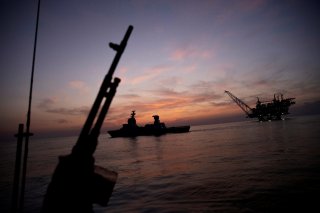Why Israel’s Sa'ar Stealth Corvettes Make Hezbollah Shudder
They utilize stealth technology that could make the vessels harder to detect by one or more radar, visual, sonar or infrared methods, for one.
Here's What You Need to Remember: This next generation of missile boats have been seen as crucial to defending Israel’s offshore strategic natural gas industry from the threat of terrorist groups, such as the Lebanese-based Hezbollah. The vessels will be at the forefront of INS efforts to protect the more than 200-mile exclusive economic zone (EEZ), which has become a significant national asset for the Jewish state.
While one of the State of Israel’s smaller military branches, the Israeli Navy is actually active in multiple theaters including the Mediterranean Sea, the Gulf of Eilat and the Red Sea. It is also believed that the Israeli Navy is responsible for maintaining the nation’s offshore nuclear second strike capability.
Currently, the Israeli Navy—which was founded in 1948 and has some 10,000 active duty personnel—consists of three Sa’ar 5-class corvettes, eight missile boats, five submarines and some forty five patrol boats as well as two support ships. Beginning this year the Israeli Navy will see a significant upgrade when it receives the first of the German-made Sa’ar 6 missile corvettes from the “Project Magen.”
Four of the warships were ordered in May 2015, and in March of this year a photo released online showed the first of the vessels—named INS Magen—undergoing sea trials. The Sa’ar 6 corvette class vessels are now being built by the German TKMS for Israel, and the warships are based on the design of the German-made MEKO 100 patrol corvette. The ships will have an overall length of 90 meters, a maximum beam of 13.2 meters and a height of 21.5 meters. Displacement of the Sa’ar 6 will be approximately 2,000 tons.
According to Naval Recognition, INS Magen was built utilizing stealth technology construction techniques that could make the vessel harder to detect by one or more radar, visual, sonar or infrared methods.
Delivery of the vessels, which cost a reported $480 million with the German government covering about one quarter of the cost, were scheduled to arrive earlier this year but were delayed to the ongoing novel coronavirus pandemic.
Defending Israel’s Waters
This next generation of missile boats have been seen as crucial to defending Israel’s offshore strategic natural gas industry from the threat of terrorist groups, such as the Lebanese-based Hezbollah. The vessels will be at the forefront of INS efforts to protect the more than 200-mile exclusive economic zone (EEZ), which has become a significant national asset for the Jewish state.
Additionally, Israel has seen a rising threat from the navy capability of Hamas, which has been training commando teams to operate a “frogmen team” to strike against Israel targets along the Gaza coast.
The corvettes will certainly be a significant deterrence and are armed with an Oto Melara 76 mm main gun, two Typhoon Weapon Stations, 16 vertical launch cells for Barak-8 surface-to-air missiles,40 cells for the C-Dome point defense system, 16 anti-ship missiles, the EL/M-2248 MF-STAR AESA radar, and two 324 mm torpedo launchers. The warships will also have hangar space and a platform able to accommodate a medium-class SH-60-type helicopter.
When the first of the vessels, INS Magen—Hebrew for “Shield”—arrives later this year, it could certainly live up to its name and help protect the Israel coast and its crucial gas reserves from threats.
Peter Suciu is a Michigan-based writer who has contributed to more than four dozen magazines, newspapers and websites. He is the author of several books on military headgear including A Gallery of Military Headdress, which is available on Amazon.com. This article first appeared last year and is being republished due to reader interest.
Image: Reuters.

